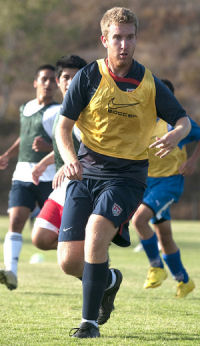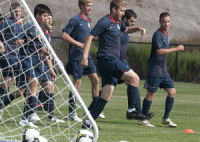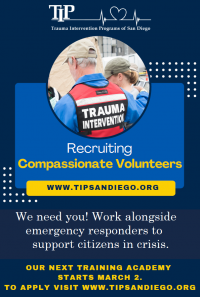Story and photos by Ron Logan

June 16, 2011 (La Mesa)Chris Ahrens is a school teacher and an elite athlete. For months on end he has trained long hours in preparation for this month’s world championships in his sport.
His team departed on June 13th for the 2011 CPISRA Football 7-a-side World Championships in the Netherlands (that’s soccer, to you and me). Ahrens is a defender for the U.S. team.
The Dutch tournament is the last opportunity for the U.S. to qualify for London 2012. I am not referring to the 2012 Olympics but rather the 2012 Paralympics which are held at the same venues a few weeks after the Olympic flame has been extinguished in England. The Paralympics are for athletes with physical disabilities. But honestly, these athletes are more capable than me in many ways.
To compete on the Paralympic soccer team, athletes must have a disability from either cerebral palsy, traumatic brain injury, or stroke. Like the majority of his teammates, Ahrens has cerebral palsy (CP).
“It affects the entire left side of my body,” said Ahrens. “I was born with it. We think it came from a lack of oxygen from the umbilical cord being wrapped around my neck.”
When you meet Ahrens, he is a typical guy. He is intelligent, well-spoken, well-educated, and possesses a great sense of humor. There is nothing that would tip you off to the fact that he has CP. But, if you watch him closely you can detect a slight limp in his gait and a crookedness to his left arm and wrist.
On a personal note, having worked with his team for about two years now, I’ve learned a lot about disabilities – what they are, and what they are not. One of the most intelligent people I’ve ever met, Jason Slemons, is a teammate of Ahrens. He has a bachelors degree in mathematics, two master’s degrees – one in number theory and one in numerical linear algebra and scientific computing – and a PhD in applied mathematics. I’m not even sure I understand what it is he does. I struggled with algebra.
Ahrens grew up in New York. By high school he knew he wanted to pursue a career in adaptive physical education.
“My CP played a part in my decision about my career,” Ahrens added. “My sister is a physical therapist's assistant and worked for a school for kids with cerebral palsy, much more severe than mine. She told me about adaptive PE at the school and I thought ‘that sounds really cool, I might really enjoy that ’cus I can relate.’”
Ahrens, now a resident of La Mesa, received his education at SUNY College of Brockport. “My undergrad is in physical education with concentrations in teacher education, and adaptive physical education, and I have a master's degree in adaptive physical education.”
While in college, Ahrens learned about the U.S. Paralympic National Soccer Team. “I’d known about the Paralympics for some time,” said Ahrens. “We had a family friend swim in the ’96 games in Atlanta. So I was exposed to it then, and then also through some disability sport classes in college. I was poking around the U.S. Paralympics web site to see what they had to offer and I stumbled across the soccer team. It was specifically for people with CP, as well as similar conditions like traumatic brain injury and stroke. I got in touch with Dana Schoenwetter, the team manager, and she wanted some information about my playing  history. Now I’ve been on the team since 2006, five years.”
history. Now I’ve been on the team since 2006, five years.”
With an Aching in my Heart
After college, Ahrens moved to Southern California which placed him much closer to the team training camps at the Olympic Training Center in Chula Vista, but also placed him 2,200 miles away from his family. “I got offered a job with San Diego Unified School District (SDUSD),” Ahrens explained. “I had finished my masters at a very awkward time for a teacher – I finished it in December. The job in San Diego was being vacated by a former Brockport alum because her husband was in the military and they were being relocated. She got in touch with the professor at Brockport and asked him if anyone needed a job. The professor forwarded it to me. Then while I was out here at a training camp I interviewed with SDUSD and they offered me the job. It wasn't an easy decision, but soccer was a huge factor in me taking the job. Because training camps are here in San Diego, it just made sense that it would allow me to continue training with the team.”
When Ahrens joined the Paralympic team he hadn’t played organized soccer for many years. But his progress, as well as the team’s, has been exponential since then.
“For the past three years, [Head Coach] Jay Hoffman has been focused on one goal: building a roster and a team that can qualify for the 2012 London Paralympic Games,” said Jim Moorhouse, Director of Youth National Teams (which also includes the Beach Soccer, Futsal and Paralympic programs) for U.S. Soccer. “He’s expanded the player pool and created a superb training environment for the team.”
That training environment has enabled the team to make great gains in training and the team has played very well in recent competition. The U.S. team is currently ranked 9th in the world.
“We’ve come really far, Ahrens said. “When I first came to the team it was kind of a transition period – two years after Athens, which they did not qualify for. We were in a transition period, and the truth was we didn't have a lot of true soccer players. We had a lot of guys masquerading as soccer players, in fact I was one of them then. I continued to work hard, but then when we didn't qualify for Beijing the staff decided to move in a new direction and bring in a lot of new players ... a lot of these players now are guys who grew up playing the game, that have played consistently. They’re not just somebody with CP or stroke that we are trying to turn into a soccer player. A lot of them are pretty young and they have to learn that it’s international competition, which means it is as competitive as anything you will find ... It is a lot different from where they were coming from. But we've also improved greatly which was evident by our silver medal at the Copa America, which is our regional championship. Things started to click in Buenos Aires [at the Copa America] and we are just looking to go forward from there and use it as momentum.”
One of the biggest obstacles for the Paralympic team is keeping the players in-shape and game-ready between camps. The team is only together in camp for a week or two every few months. The training and conditioning becomes the responsibility of each member of the team. It takes great discipline to train at this level while continuing with everyday life. Some of the players are still just teenagers – others have careers and families.
“The tricky thing about this team is that we all have full-time jobs or are full-time students, and it makes it hard,” explained Ahrens. “Through our coach's contacts, or our assistant coach's contacts, I've been paired up with a couple local club teams which allow me to train with them. I train with San Diego United [El Cajon], about two nights per week, and then with Crusaders Soccer Club [San Carlos], one or two nights per week, depending – which is huge for me because the kids that play, their athleticism resembles the teams that we play. It is very important that I get touches on the ball, and train at a high level. On top of training with those teams I do conditioning on my own. On the days I don't train with the clubs I try to get some sort of weight training in, and if further conditioning, like running, needs to be done for whatever our fitness program from coach calls for, then I fit that in someway, somehow, in my busy schedule. When I train with the clubs I don’t want to give the Paralympic team a bad image, so I show up and train hard, and get better so I can gain a little respect from them.”
“It is always a pleasure and an advantage to have Chris at training because he always brings a level of professionalism as well as high standards to training,” said Rene Miramontes, Director of Coaching for Crusaders Soccer Club and former U.S. Soccer coach. “He is truly an example and an inspiration to our U-15 team and certainly raises the quality and effort of the whole group. I am always delighted to have Chris at training.”
On top of all the soccer conditioning, and his career, Ahrens finds time for his girlfriend, Pam. “Thank goodness she's understanding,” he said. “She knows it's important to me. She's a huge part of my support system. Since my family is back in New York, she pretty much IS my support system. When soccer is going bad, she is the one who hears about it. When soccer is going good, she is still right there hearing about it. I certainly think she doesn't get enough credit for that because soccer takes time away from her, but, she takes it all with a smile. I just try to be conscious that I need to make time to see her, to be with her and to be there to support her in her professional life, her career. As much as she supports me she deserves that right in return, too.”
So has all the training and sacrifice paid off?
 As a five-year veteran, Ahrens plays a pivotal role with the Americans. “Chris has become a very important member of the team, said Coach Hoffman. “He brings maturity, leadership, and a work ethic to be emulated by all of the younger players. He certainly has grown over the years as a player, and his commitment to the program and team is to be commended.”
As a five-year veteran, Ahrens plays a pivotal role with the Americans. “Chris has become a very important member of the team, said Coach Hoffman. “He brings maturity, leadership, and a work ethic to be emulated by all of the younger players. He certainly has grown over the years as a player, and his commitment to the program and team is to be commended.”
“My role on the team is to be a leader, to set a good example for the other players, to play hard,” Ahrens added. “I’m not the most skilled player on the team but I consider my work rate to be high and hopefully that rubs off on other people. Coach has some confidence that I see and read the game relatively well, so he expects me to have things organized out there. Guys marked up. Calling things out. Staying organized.”
Going Dutch
Heading into the world championships in Holland, Coach Hoffman is confident about the U.S. outcome. "This is the final qualifying opportunity for the 2012 Paralympic Games in London,” said Hoffman. “We will need to finish in the top seven to secure our participation – the host country Great Britain is guaranteed a position. Our group includes Japan, Iran and Ireland, not an easy feat but very doable."
“With it being only a sixteen team tournament we don’t have the luxury of an easy group,” Ahrens continued. “We are going to play teams ranked in the top four and top eight, in which we are just on the cusp of ourselves. Then also, the teams we play that are ranked below us are nipping at our heels to get to where we are if not higher. In every tournament it seems the game has improved as a whole across the board.”
“The first game is Japan,” said Ahrens. “We played them in 2009. We beat them 5-0. We haven't seen them in a tournament since then. They play hard though. No question that Japan will come there to fight for results. It will be a hard fought game.”
Next up is Iran. “They are consistently medalists at world championship tournaments,” Ahrens said. “They have yet to win one, but the last two they've gotten second and third respectively and they won bronze at the Paralympics. They are an elite-level team, but we've played well against them in the past. We drew them in our group in ’07 and we were up 1-0 for about 40 minutes, but then they eventually proved to be too much beating us 3-1. They are one of the most talented teams in the world, no questions asked. But on any given day, if we keep our shape in the back, we can get a point or maybe three points [in the standings] out of it.”
Ahrens wrapped up their final Group D opponent like this, “Ireland is a team that has improved over the last three or four years. I believe they recently got third in the European championships, which is the most competitive region in the world for us. They are a team that may not look great on paper, but are probably one of the hardest working teams in the world. We have toughened up a lot over that past few years, as well, so I think we match up pretty well with them.”
Will the U.S. team qualify for London?
“Yeah,” said Ahrens. “It's not going to be easy, and that’s what makes it great.”
 The U.S. Paralympic Soccer Conundrum
The U.S. Paralympic Soccer Conundrum
Although the U.S. Paralympic National Soccer Team has been in existence for more than a quarter century now, the program continues to struggle with two major hurdles – one, a problem with visibility, and two, a problem with identity.
When I asked Chris Ahrens “What is the biggest obstacle for the Paralympic soccer team?” his answer was not unexpected. “Exposure. For sure,” Ahrens replied. “I watch Fox Soccer and I see the U.S. Youth Soccer Show, and I log onto ussoccer.com and read about them sending an entire film crew to the Caribbean to cover the Under-17s, not even for the U-17 World Cup, but for their World Cup qualifiers. I’m not saying any of those things are not deserving of the time they get – because everybody deserves their piece of the pie too – but, we certainly have to fight a lot harder for the limited amount of exposure we get. It seems as though to get featured on certain web sites, or TV – forget about it – and even to get into newspapers it’s been a fight,” Ahrens said. “Exposure is hard.”
When scouring the internet for information about the U.S. team, the pickings were slim. That problem with lack of exposure spills into the other problem: the team’s identity.
“We have a web site now, and YouTube page, and a Facebook fan page [which just reached 1200 fans], so social media has certainly helped us. But, a lot of people just don’t know the program exists. And if they do know it exists, whether or not if it is for them, or if they qualify, or who it is for. We [Paralympics] are often confused for other organizations [namely the Special Olympics] that we are not. So, I think the lack of exposure, along with the confusion about the Paralympics, hurts us. People don't automatically associate the Paralympics with the Olympics. I would like to see people start to make that association.”
The lack of exposure and confusion about the program, combined with a limited part-time staff that runs the Paralympic soccer team while they juggle full-time careers, makes recruitment of new players extremely difficult.
“Although 16-20% of returning soldiers have traumatic brain injury, only one has come out to train with us,” Ahrens said. [That ‘one’ is former U.S. Army Sargent Gavin Sibayan, who was hit by IEDs three times while serving in Iraq. He suffered traumatic brain injury (TBI) when the third IED sent shrapnel into the left side of his head.] Ahrens continued, “We should have more recruitment from the military. I know U.S. Paralympics does a lot with the Wounded Warriors Project, but, from our perspective – while it seems like U.S. Paralympics is growing and getting their name out there – I kinda feel like we are being left behind a little bit.”
Although the Paralympic soccer team remains mostly unknown even inside the soccer community, the acceptance of disability in general is making gains in mainstream American culture.
“As a society we have made great strides,” Ahrens notes. “I mean, we are now seeing disabled athletes in Nike commercials. As inspirational as I don't think I am, people are always saying 'You are amazing. You have overcome so much.' But I can't tell you a single thing I've overcome. I've lived a pretty normal life. I grew up playing able-bodied sports with able-bodied kids. Was I ever the best? No, absolutely not ... but my disability didn't really hold me back until the teenage years when kids sort of separate themselves a bit. As people with disability, we just want to be playing with our friends – and our friends wouldn't be playing in a disability league.”
But Ahrens points out that there are also advantages to participating in disability sports. “If you flip that, it can also be a great opportunity,” Ahrens explained. “I never knew anyone else with CP until I joined the team. If these types of programs exist it offers an opportunity to meet new people.”
The problems with exposure and identity do not appear to be specifically a problem inside the soccer community. Ahrens concludes, “Soccer seems to be trying pretty hard with regard to disability sports. But I think it comes down to a lack of advertising and a lack of promotion. Seems like certain web sites are interviewing anyone and everyone except us. The lack of exposure is the problem. We’re just not known about.”
U.S. Paralympic National Soccer Team Roster
The following is the U.S. roster for the 2011 CPISRA World Championships:
Player (Position) Hometown (Birth Date) Condition
Chris Ahrens (D/M) Baldwinsville, N.Y. (01/31/84) CP
Adam Ballou (M) Virginia Beach, Va. (05/29/92) CP
Tyler Bennett (M) Wadsworth, Ohio (06/27/92) CP
Bryce Boarman (D) Colorado Springs, Colo. (09/29/90) CP
Nick Creasey (M) Rishmond, Va. (01/09/91) TBI
Charlie Howard (F) Washington, D.C. (06/16/95) CP
Keith Johnson (GK) Houston, Tex. (07/02/80) CP
Chad Jones (D/M) Virginia Beach, Va. (02/25/92) CP
Tommy Latsch (M) Euclid, Ohio (01/07/85) CP
Josh McKinney (M) Cary, N.C. (01/18/79) CP
Jason Slemons (D) Seattle, Wash. (11/16/79) CP
Marthell Vasquez (M/F) Long Beach, Calif. (04/08/87) CP
U.S. First Round Schedule
USA vs. Japan
Sunday, June 19, 2011
7:30 p.m. (Local Time)
10:30 a.m (Pacific Time)
Location: Assen, Netherlands
Stadium: Achilles 1894
Iran vs. USA
Tuesday, June 21, 2011
5:00 p.m. (Local Time)
8:00 a.m (Pacific Time)
Location: Emmen, Netherlands
Stadium: SC Angelslo
Ireland vs. USA
Thursday, June 23, 2011
7:30 p.m. (Local Time)
10:30 a.m (Pacific Time)
Location: Hoogeveen, Netherlands
Stadium: VV de Weide
Complete schedule available at: www.wkcp.nl/ENG/Matches_Results_.html
Paralympic Soccer Primer
To be eligible, players must be male and possess a physical disability from a medical diagnosis of cerebral palsy (CP), traumatic brain injury (TBI) or stroke.
Prospective players are often identified as early as 12 or 13 years of age but must be 15 in order to compete internationally.
Competition is governed by the Cerebral Palsy International Sports & Recreation Association (CPISRA), while the U.S. team itself is co-governed by the U.S. Soccer Federation and U.S. Paralympics.
Prior to entering competition each player is evaluated and classified. Eligible classes for soccer are C5, C6, C7 & C8. Counterintuitively, the classes do not signify the severity of the disability, but rather categorize the players based on other criteria.
The conventional FIFA laws of the game apply but with the following exceptions: The field of play is smaller, the goals are smaller, each team plays with seven players rather than the traditional eleven, there is no offsides law, and players are allowed to roll the ball into play underhand (rather than an overhead throw-in) to accommodate their physical limitations. Each team must field at least one class C5 or C6 player at all times and can have no more than two class C8 players on the field together during a game.
According to FIFA’s “The Big Count, 2006,” there are over 24 million soccer participants in the United States. Although the sport has become embedded in American culture, the Paralympic soccer team remains much of a secret – even inside the close-knit American soccer community. The team has been in existence for over 25 years.
In the U.S., cerebral palsy occurs in approximately one in every 500 births, and the population of people living with CP exceeds 750,000. Each year nearly half a million children under the age of 14 suffer from TBI. Every year 600,000 people suffer a stroke.
Even with those staggering numbers, the U.S. Paralympic National Soccer Team’s player pool hovers around 30 athletes. There are many factors to blame. An inadequate budget for promotion and advertising, a lack of a full-time staff, and the public’s on-going confusion between the Paralympics and the Special Olympics are key obstacles.
The team’s most recent camp concluded June 8 at the Olympic Training Center in Chula Vista, Calif. That was the final camp in preparation for the 2011 CPISRA World Championships in the Netherlands, to be held June 17 through July 1. The Dutch tournament is the final opportunity for the U.S. to qualify for the 2012 Paralympic Games in London. The U.S. is currently ranked ninth in the world. For more information about the tournament in Holland, or to follow the results, visit:www.wkcp.nl/ENG/home.html
To learn more about the U.S. Paralympic National Soccer Team, of if you know someone who may be interested in participating, please contact team manager Dana Schoenwetter at dana.schoenwetter@usoc.org or visit these web sites:www.youtube.com/rlogan2009 and www.soccerparasite.com and www.facebook.com/pages/US-Paralympic-National-Soccer-Team/26346828571






















Recent comments